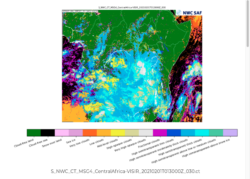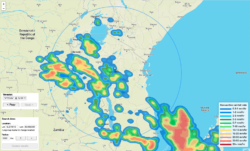African SWIFT (GCRF)
Introduction
Launched in 2017, GCRF African SWIFT (Science for Weather Information and Forecasting Techniques) is a £9 million programme led by the National Centre for Atmospheric Science (NCAS) and funded by the Global Challenges Research Fund. The programme includes partners from universities and national meteorological services in Ghana, Kenya, Niger, Nigeria, Senegal and the UK.
CEMAC's role in the project is providing support for developing and using computational tools across a range of work packages. CEMAC has also contributed to several additional activities which have arisen during the project lifecycle.
- African SWIFT project management tool
- Work Package 3: Remote Sensing (Satellite)
- Work Package 4: Nowcasting
- Work Package 5: Synoptic Methods
- Work Package 7: Convection Permitting (CP) Ensembles
- Work Package C2: Testbeds
- African SWIFT related support
African SWIFT project management tool
https://swift-pm.herokuapp.com/
A web-based project management tool to support the reporting activity of work package leaders, developed by CEMAC after dialogue with the SWIFT project management team to understand their existing Excel-based system. The web application provides an interface that allows the SWIFT project management team to report on the project progress, set tasks, define deliverables and so on. The tool was built using the cloud application platform, Heroku, with a PostGRES database backend allowing regular backups and rollback. Feedback from end-users was implemented in a staging area for testing ahead of roll-out.
Work Package 3: Remote Sensing (Satellite)
CEMAC provided support to researchers to access HRIT satellite data from EUMETSAT archives. Automated downloading of this archived data is challenging due to access limitations and latency. CEMAC developed a data download pipeline combining an automated form-filling tool, Selenium, with scripts to download data when available. This approach enabled researchers to access satellite data covering two months per year during the 10 year study period.
Work Package 4: Nowcasting
Work Package 4 focuses on the provision of tools for African meteorologists to become self-sufficient in nowcasting. CEMAC have supported work on automatically generating images from satellites for forecasting in near real time in collaboration with NCAS systems architects and SWIFT PDRA, Alex Roberts. Following the successful development of an operational set up at STFC Chilbolton Observatory, provision of a second system at Leeds is in progress and CEMAC are involved in plans to develop a web gateway/portal to allow dynamic inspection of nowcasting data.
Work Package 5: Synoptic Methods
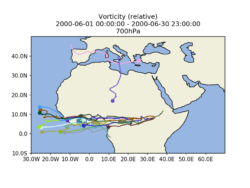 The aim of Work Package 5 is to develop new and existing synoptic methods for forecasting in Africa. Work has been undertaken by CEMAC in collaboration with SWIFT PDRA, Samantha Clarke, around the tracking of vorticity and mean sea level pressure in ECMWF data sets. The initial piece of work involved converting an existing piece of NCL code for vorticity tracking to Python, which was then further developed and enhanced, including parallelising sections of the code.
The aim of Work Package 5 is to develop new and existing synoptic methods for forecasting in Africa. Work has been undertaken by CEMAC in collaboration with SWIFT PDRA, Samantha Clarke, around the tracking of vorticity and mean sea level pressure in ECMWF data sets. The initial piece of work involved converting an existing piece of NCL code for vorticity tracking to Python, which was then further developed and enhanced, including parallelising sections of the code. 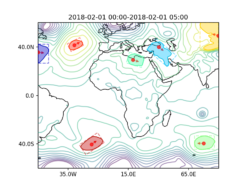
This was followed by developing similar code for the tracking of MSLP data, for which there was not an existing method. This allowed more freedom in the development of a suitable method. The bulk of the tracking work now appears to be done, with ongoing work including assistance with analysis and plotting of the tracking output, as well as producing code to help relate the tracking output to other data sets.
Work Package 7: Convection Permitting (CP) Ensembles
This work package deals with high resolution NWP ensembles of partner state regions, specifically central and east Africa, with the University of Reading leading on the ensemble work. CEMAC's role is in supporting University of Leeds PDRAs to run high resolution simulations associated with the African SWIFT Testbeds and summer school. CEMAC developed scripts to retrieve and convert meteorological data from Met Office Managed Archive Storage System (MASS) via the MOOSE retrieval interface. There were challenges associated with the workflow for download and conversion on JASMIN.
Work Package C2: Testbeds
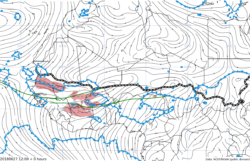
Prototype automated West Africa synthesis/analysis showing intertropical discontinuity (ITD), mid-level dry intrusion, African Easterly Jet and areas of high wind shear
For Testbed 3, CEMAC will create a tool for synthesis of synoptic features for Africa. The tool automates plotting of synoptic features which would otherwise be drawn manually. The tool will be developed for use as a training tool in Testbed 3 workshops in 2021.
CEMAC SDS Helen Burns will lead the IT Scientific working group for Testbed 3.
African SWIFT related support
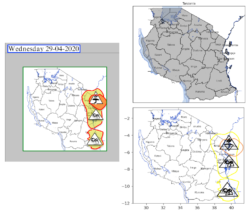
Schematic showing alert elements extracted from TMD weather warning PDF and converted to standard projection
CEMAC is supporting African SWIFT PhD student Hellen Msemo to obtain weather warning data issued by Tanzanian Meteorological Department for assessing accuracy of forecasts against satellite data. Vector data is extracted from PDFs and transformed to a coordinate grid to allow comparison with satellite data. Additionally, metadata, such as issue date, alert date, weather detail, is stored. The combined data is output as netCDF for downstream analysis. Challenges include identifying the weather type from abstract graphics, which necessitates a manual step to annotate the netCDF data.
FASTA
FASTA is an African SWIFT related project to develop an application programming interface to provide nowcasting information for Africa. Initially, this will be rolled out for Kenya, with plans to extend coverage to include other African meteorological agencies. CEMAC is providing support for the operational workflow in collaboration with NCAS IT manager and an external API developer.

